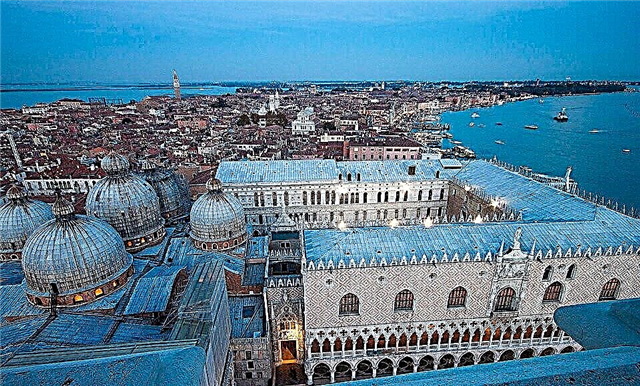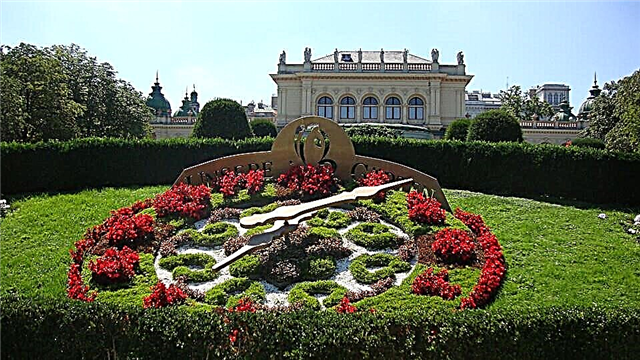Address: Russia, Nizhny Novgorod region, Nizhny Novgorod, Sovnarkomovskaya street, 13
Build date: 1890 year
Architect: Treiman K.V., von Gauguin A.I., Trambitsky A.E.
Coordinates: 56 ° 19'42.4 "N 43 ° 57'39.4" E
Content:
Even those who have never been to the Volga city have heard about the famous Nizhny Novgorod fair. It appeared here at the beginning of the 19th century and quickly became not only a bustling place of purchase and sale, but also a real cultural center. Thanks to the fair, the service sector has developed in the city, new hotels and restaurants have appeared. Today the revived fairground complex is much smaller. However, he gained recognition by hosting international and Russian exhibitions and forums.

View of the Nizhny Novgorod fair from the opposite side of the Oka
What happened before the Nizhny Novgorod fair
After the troops of John IV the Terrible conquered the Kazan Khanate, the left bank near the Makaryevsky Monastery, 85 km away from the city down the river, became the place of active trade in the middle reaches of the Volga. At first, merchants traded here only once a year - on the day of commemoration of the founder of the monastery, Saint Macarius (July 25, old style). The fair that appeared was convenient for everyone and grew from year to year.
In 1641, the Russian Tsar Mikhail Fedorovich Romanov allowed the monastery to collect a duty from merchants once a year. By the 60s of the 17th century, not only Russian merchants began to come here, but also merchants from other countries. The noisy fair lasted two weeks. And gradually its areas expanded so much that they captured the right bank of the river.
By the beginning of the 18th century, about 60 thousand people traded at the Makaryevskaya fair, and the annual turnover was 1/10 of the then budget of Russia. Salt, handicrafts, horses, livestock, Siberian furs and bells were sold here. Merchants brought here English cloth and Indian fabrics, steel and copper, gold products and carpets.
The buildings for the fair were made temporary, because trade did not take place all year round, but was carried out only in the summer. And the fair was filled with wooden shops, taverns and booths, which were rapidly decaying. In the middle of the 18th century, it was decided to build a new stone courtyard at the fair, and by the beginning of the 19th century, the reconstruction of the fair complex was completed.

Nizhny Novgorod Fairgrounds from a bird's eye view
However, very little time passed, and in 1816 there was a severe fire that destroyed almost all the fair buildings, with the exception of the new stone building. And although at this time the auction had already ended, the loss from the fire amounted to more than two million rubles. This fire and insufficient space near the monastery caused the fair to be moved to a new location. After much deliberation and calculations, the Strelka between the Oka and the Volga was chosen for a noisy and large-scale marketplace.
History of the construction of a fair complex in Nizhny Novgorod
The construction of an economic center in the Volga region was so important for the treasury that, by the decision of Emperor Alexander I, the money originally allocated for the reconstruction of the Winter Palace was used to build a new fair. The famous architect-builder Avgustin Avgustinovich Betancourt was sent to supervise the construction work.
The new fair was founded in February 1817. And in the summer of 1822, trade was already conducted here. Moreover, the fair time lasted more than a month and ended on 25 August. The territory of the retail space was striking in scale - the fair buildings spread over 8 square meters. km.
The central place on it was occupied by a large seating yard, which consisted of 60 separate buildings. More than 2,500 shops were located inside them. The main square, built in the tradition of classicism, was framed by the Main Fair House and administrative buildings. To prevent the spring flood from inundating this place, it was raised 3.5 m above the rest of the territory by erecting an artificial embankment.

View of the main entrance to the Main Fair House
Mostly Orthodox traded at the fair. But there were many merchants and other religions. Therefore, it was decided to build several temples for the fair complex at once. In the center of the artificial peninsula, a large five-domed Spassky (Old Fair) Cathedral was built. Bettencourt invited the famous architect Auguste Montferrand to build this magnificent temple. The cathedral was built for 4 years and consecrated in 1822.
After a while, under the leadership of engineer Baus, a mosque and an Armenian Gregorian temple appeared at the fair. In the Cathedral Square, unusual Chinese rows were also built, where Asian merchants traded. The main product they sold was tea.
To serve such a large-scale fair, for the first time in Russia a vaulted sewage system was created. Under the buildings, two 640 m underground galleries were erected, the floor, walls and vaults of which were lined with bricks.
In the second half of the 19th century, the Nizhny Novgorod Fair experienced a period of prosperity. It has acquired international importance. And every year, goods were sold here for almost 50 million rubles in silver. The most popular of these were cotton fabrics, woolen and silk products, as well as tea and metals.
The city at that time was inhabited by about 20 thousand people. More than 200 thousand merchants and buyers came to the fair every year. Guests needed to be served. So the brisk trade became the impetus for the construction of new city hotels, inns, teahouses, restaurants and baths.

View of the Main Fair House
The fairground itself continued to build up. Three chapels appeared here at once - Krestovozdvizhenskaya, Pecherskaya and Makaryevskaya. In honor of the arrival of Tsar Alexander II, the Alexander Nevsky Cathedral was built at the fair. The new church was consecrated in 1881 in the presence of Alexander III and members of the royal family.
In the 1860s, the first lanterns were installed on the fairgrounds, and by 1885 they had electric lighting. Large crowds of people who attended the fair could find a lot of entertainment here. From the very beginning, the fair had its own theater, the repertoire of which, according to the famous Russian playwright A.N. Ostrovsky, was not inferior to the best Moscow theaters. Concerts were held in the Main Fair House. Opera and ballet troupes from other cities came here on tour. In addition, everyone could attend circus performances.
At the end of the 19th century, the rebuilt and renewed fair hosted the All-Russian Exhibition. At the same time, the first trams were launched in the city.
What was the fair in the XX century
The First World War severely undermined the Russian economy. The fair in Nizhny Novgorod was no exception. During the war, few goods were brought to the city. And the empty premises were given to refugees and the military.
In 1918, by decision of the new authorities, the goods that were sold at the fair were allowed to be exchanged exclusively for bread. And because of this, most of the products brought to the fair remained unsold.

View of the southeast facade of the building
The new economic policy (NEP) gave the fair a second wind, and the trade turnover from 1922 to 1929 increased almost 10 times, reaching 300 million rubles. During this period, the fair acquired the status of the All-Union Exhibition. However, in 1930, the authorities decided to fight the NEP and stopped the fair trade. For several decades, the premises of the fair were used as housing. Moreover, the houses were kept in such a state that they looked more like slums. As unnecessary, religious buildings were destroyed at the fair - all the chapels, the mosque and the Armenian Gregorian temple. Only two cathedrals escaped the sad fate.
The revival of the fair began in 1990. Construction began here, and the territory was repeatedly visited by the first persons of the state.
Fair today
Today the fair in Nizhny Novgorod is a modern exhibition complex. Of the old buildings, apart from two cathedrals, only the Main Fair House has survived on it. There are 6 exhibition pavilions on the territory. There is its own bank, hotel, cafes and restaurants. The fair is used for large-scale Russian and international exhibitions, conferences and representative forums, and the sale of goods is organized in a shopping mall with an area of 1500 sq. m.

Fountain in front of the central entrance to the fair
How to get there
The territory of the Nizhegorodskaya fair is located between Sovnarkomovskaya and Sovetskaya streets, not far from the Kanavinsky bridge and the mouth of the Oka river. It is not difficult to walk from the Moskovsky railway station and the Moskovskaya metro station to the Nizhegorodskaya fair - 1.3 km. Near the fair there are bus stops and fixed-route taxis "Strelka" and "Lenin Square".











